The BEST Lemon Pound Cake (Easy + Homemade)
Lemon Pound Cake is soft and moist with a golden exterior and a tangy lemon glaze! Better yet, this easy lemon pound cake recipe makes a scrumptious dessert for Easter, spring, or summer!

WANT TO SAVE THIS RECIPE?
If you enjoy lemon treats, you'll also love Lemon Sheet Cake, topping everything with Lemon Whipped Cream, or having these Lemon Sugar Baked Donuts for breakfast. And if you love Lemon Pound Cake, I bet you'll also love Orange Pound Cake!
The time has arrived for all things lemon! I don't know what it is about springtime and the approach of Easter, but this time of year always gives me a hankering for lemon recipes of any kind...and particularly desserts. And year after year, that means I make this delectable, homemade Lemon Pound Cake!
It's hard to beat a good pound cake, but sometimes it's not so simple to create a good pound cake. Luckily, today's recipe is beyond good...it's downright delicious. Annnnd it's easy to make, to boot!
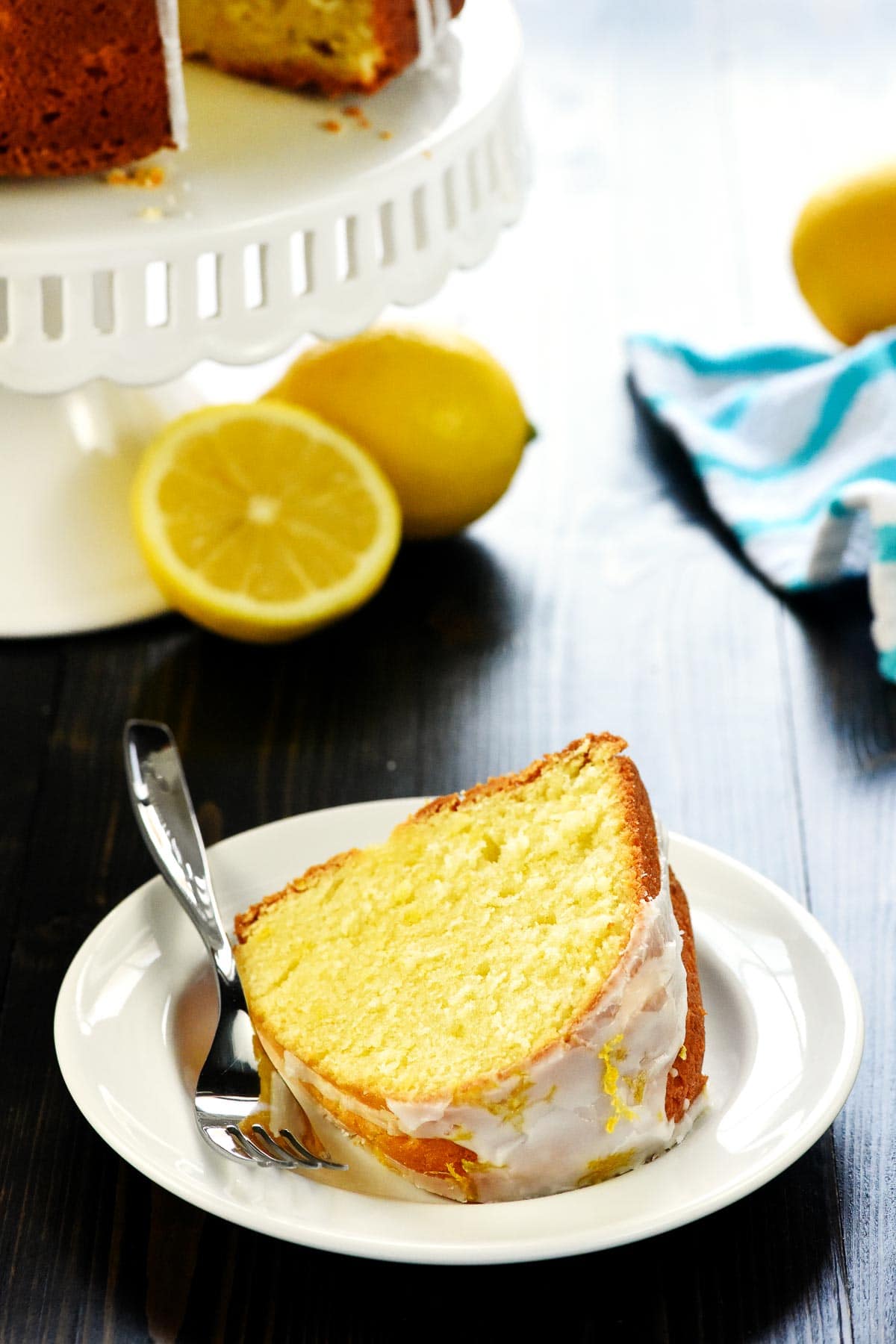
Ingredients
To create this easy Lemon Pound Cake recipe, I took a classic sour cream pound cake recipe made in a bundt pan -- the kind you'd likely find in your grandmother's recipe files or old church cookbooks -- and gave it a lusciously lemon twist.
That means that this here pound cake is from-scratch and 100% homemade! No cake mix or pudding mix in the mix -- heh.
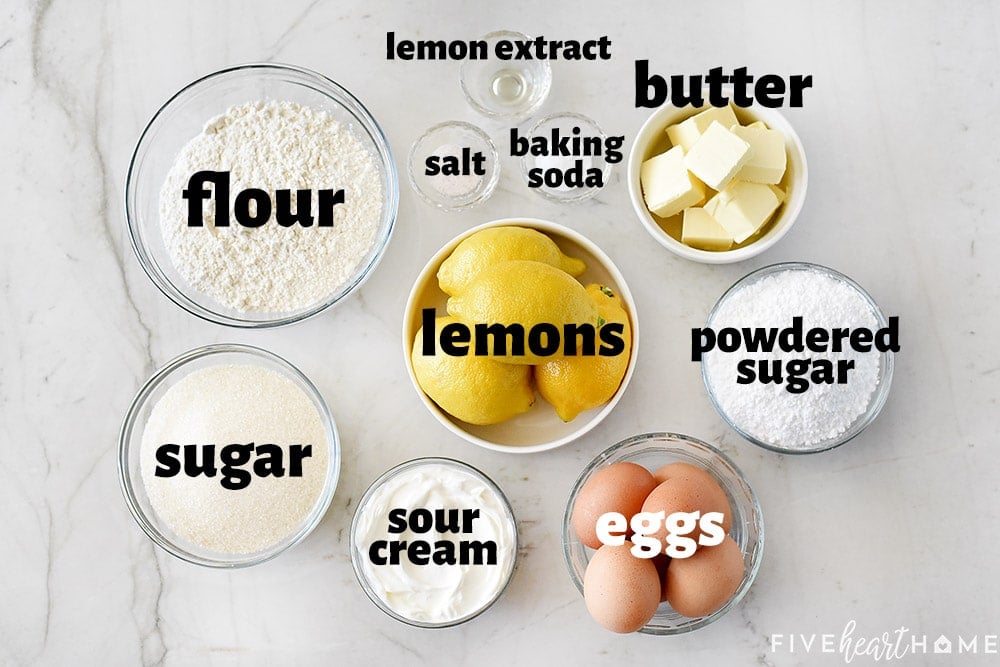
- Flour. This recipe was tested using unbleached all-purpose flour. I have not tried it with cake flour, which would likely change its traditional bundt cake density.
- Baking soda. Make sure it's fresh!
- Salt. I prefer using fine sea salt.
- Fresh lemons. Necessary for both the juice and the zest, in both the cake and the glaze.
- Unsalted butter. At room temperature.
- Sugar. Granulated.
- Eggs. At room temperature.
- Sour cream. Again, at room temperature...are we noticing a trend here? 😉 Sour cream adds richness and moisture to pound cake. I always use it when making this recipe, because I don't want to mess with a good thing. However, if you wish to substitute yogurt, I recommend using full-fat plain Greek yogurt for the most comparable texture/results.
- Lemon extract. For even more lemony flavor!
- Powdered sugar. To be mixed with lemon juice for the lemon glaze.
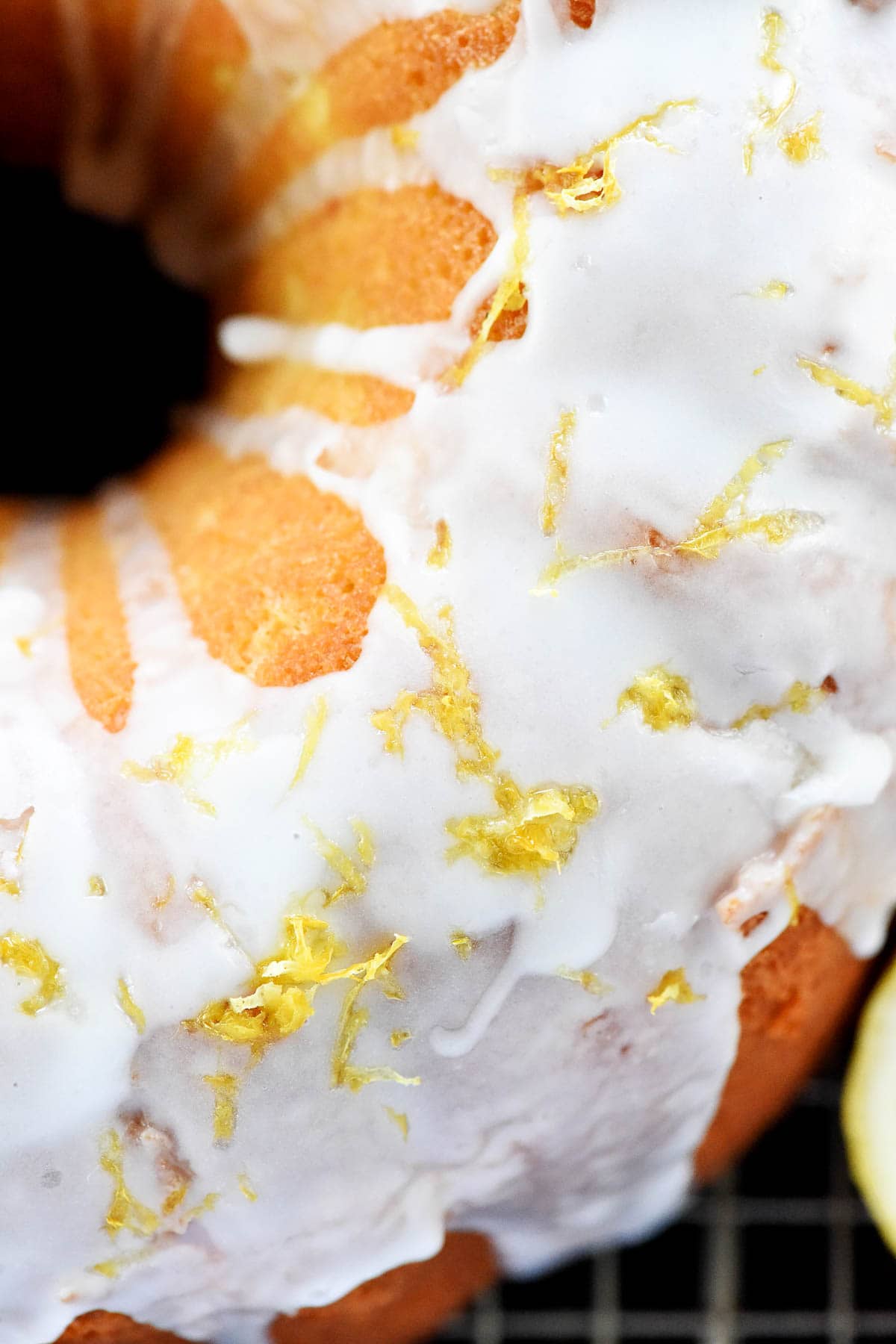
How to Make Lemon Pound Cake
(The below photos are intended to be helpful, but please refer to the recipe card at the bottom of this post for FULL DIRECTIONS.)
Let's break it down, shall we?
Make the Cake
- Preheat the oven to 325°F and generously grease and flour a 12-cup bundt pan.
- In a large bowl, whisk together the dry ingredients and the lemon zest.
- In another bowl, use an electric mixer to cream together the butter and sugar. Increase the speed and beat until light and fluffy.
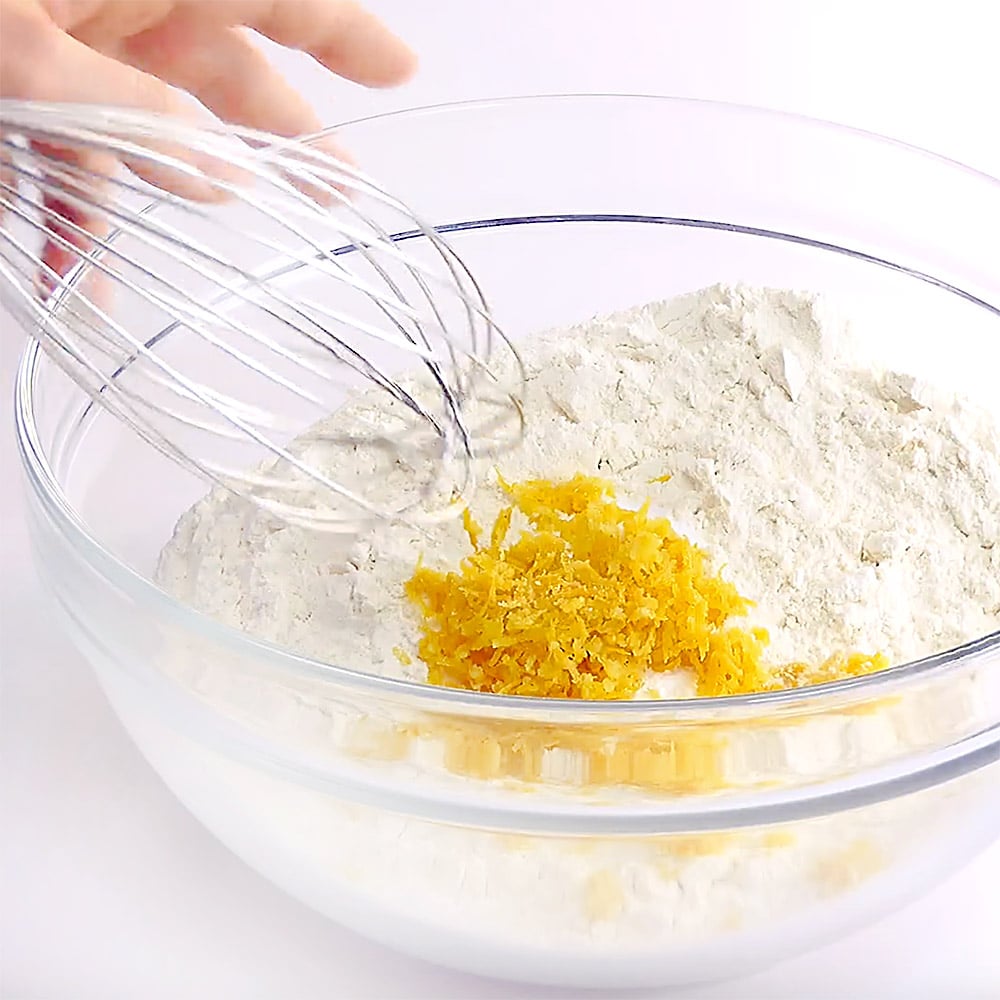
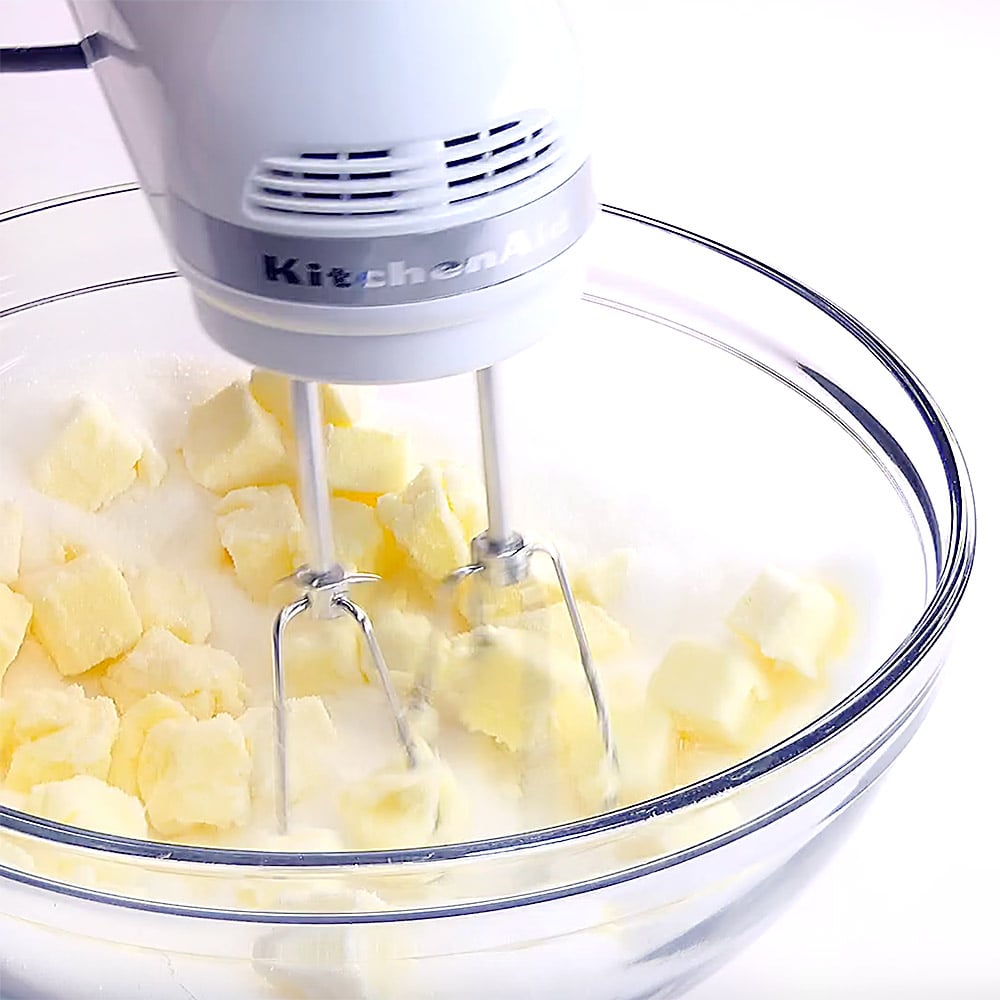
- Add the eggs individually, mixing well after each addition.
- With the mixer set to low speed, alternately add half of the flour mixture, half of the sour cream, the remaining flour mixture, and finally the sour cream.
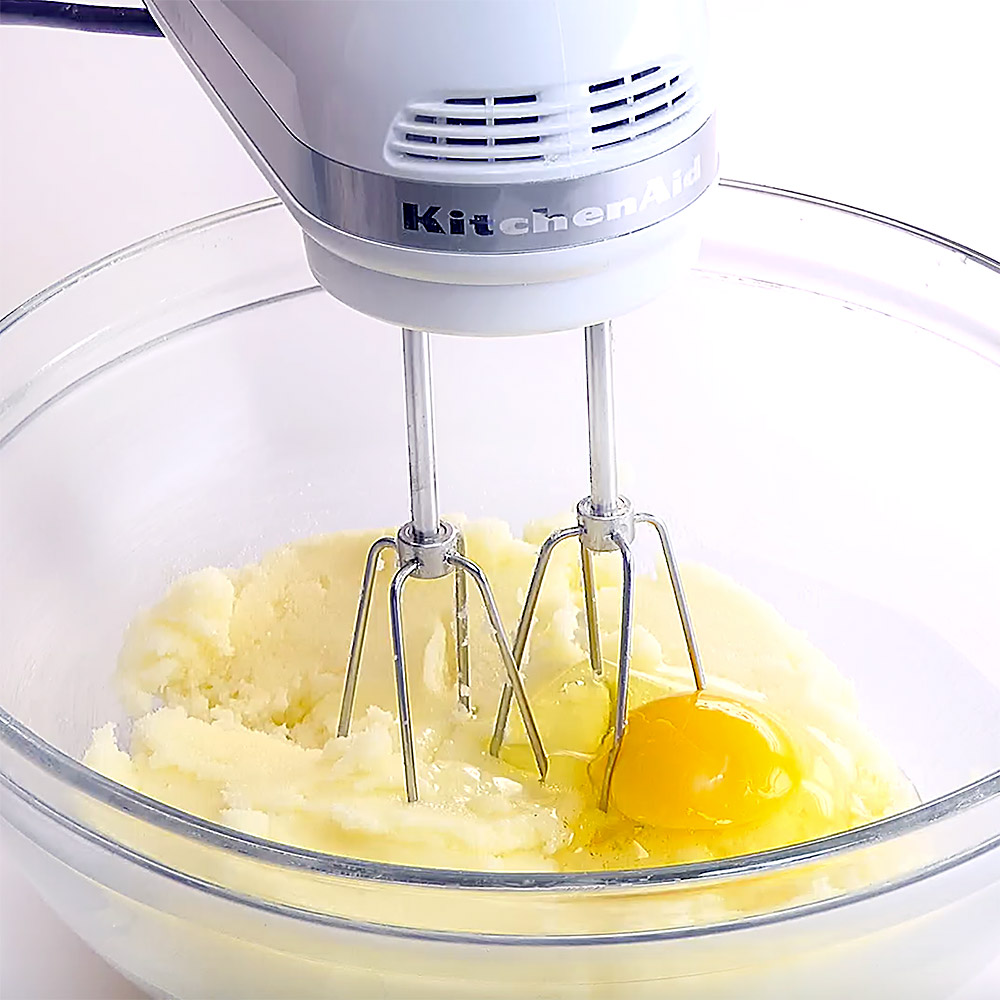
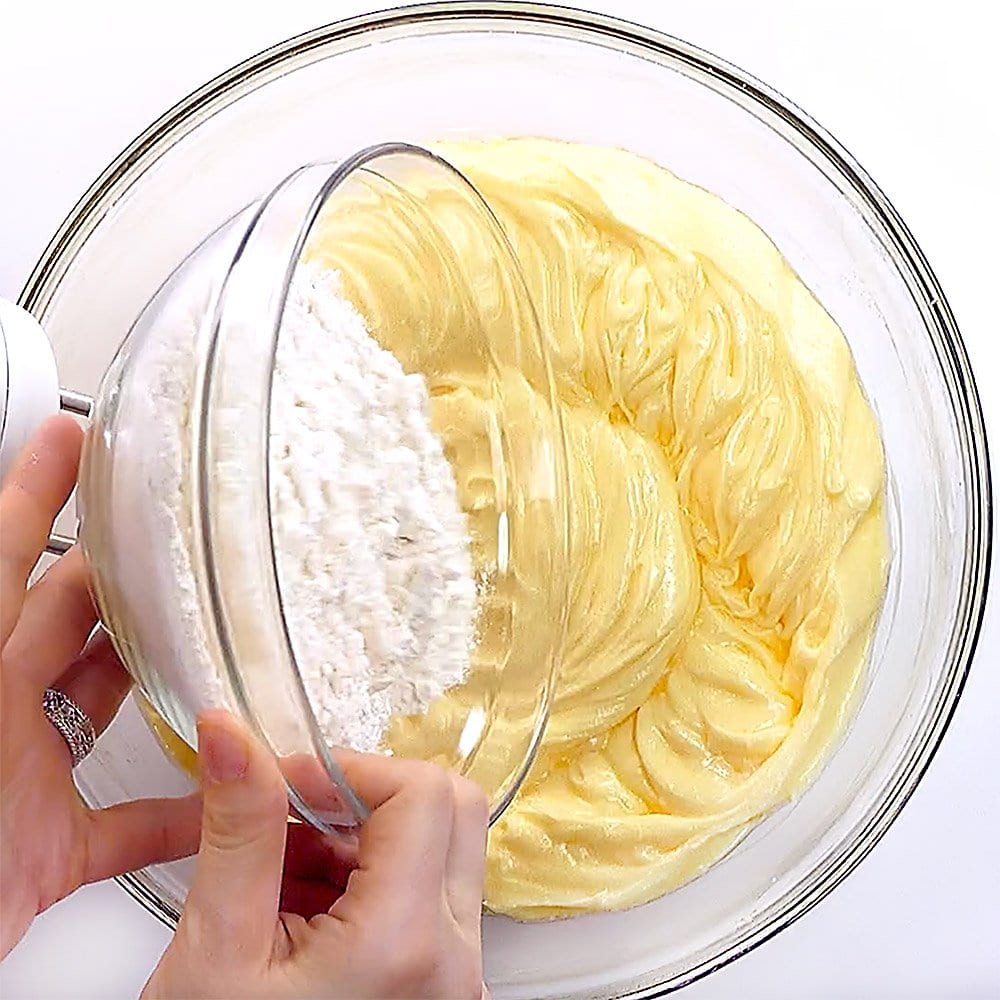
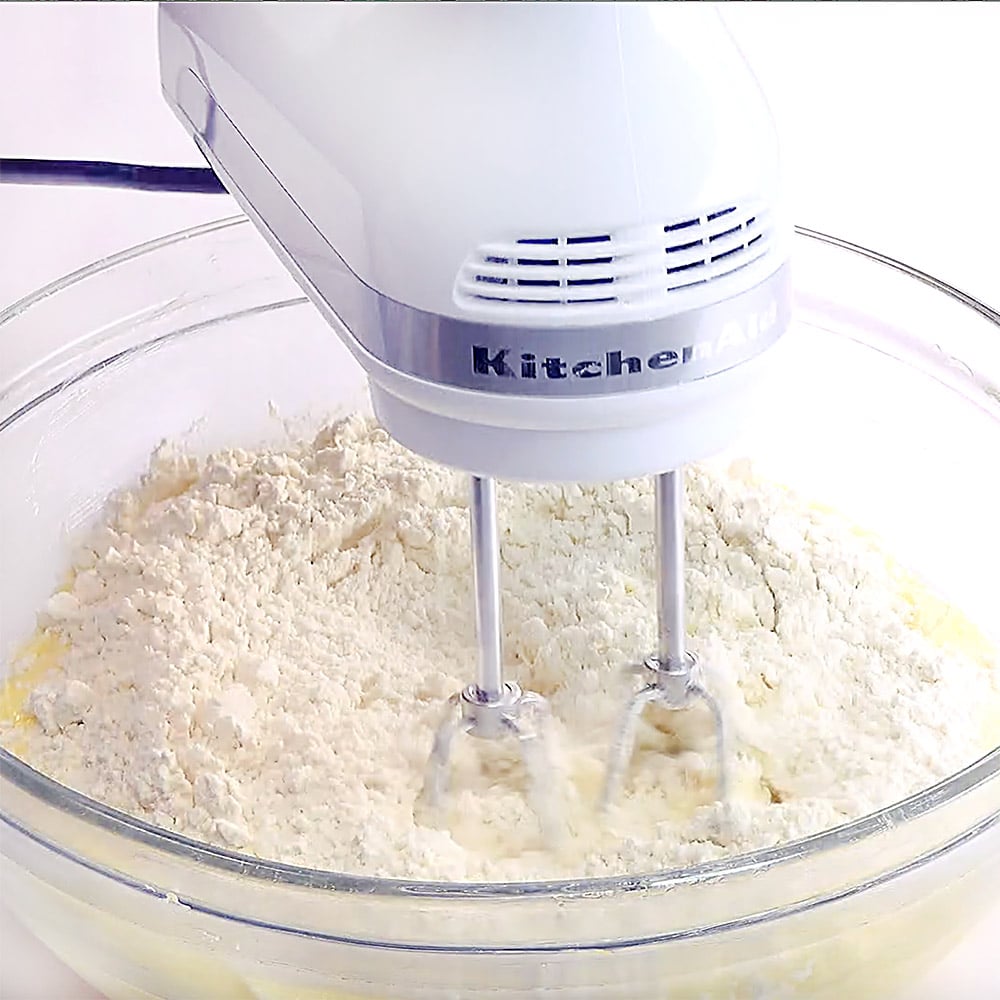
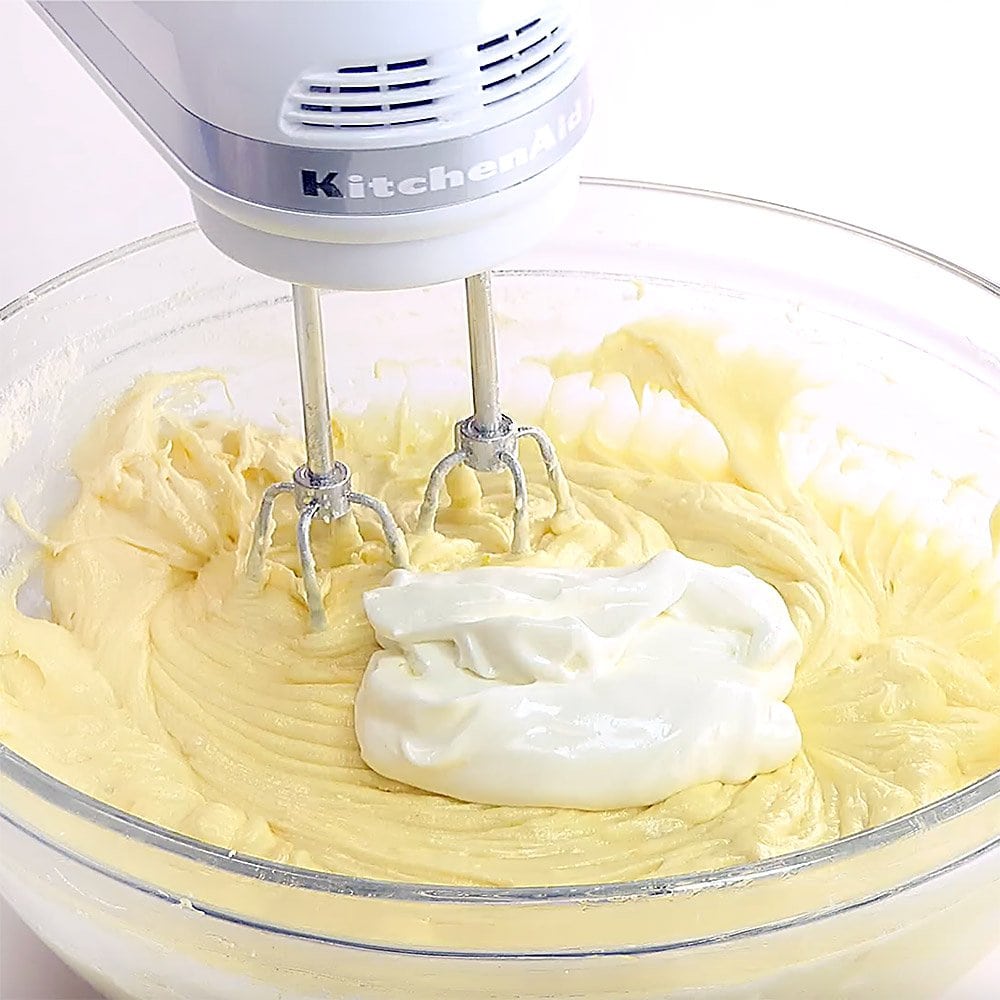
- Add the lemon juice and the lemon extract. Mix until all of the ingredients are just combined, taking care not to over-mix.
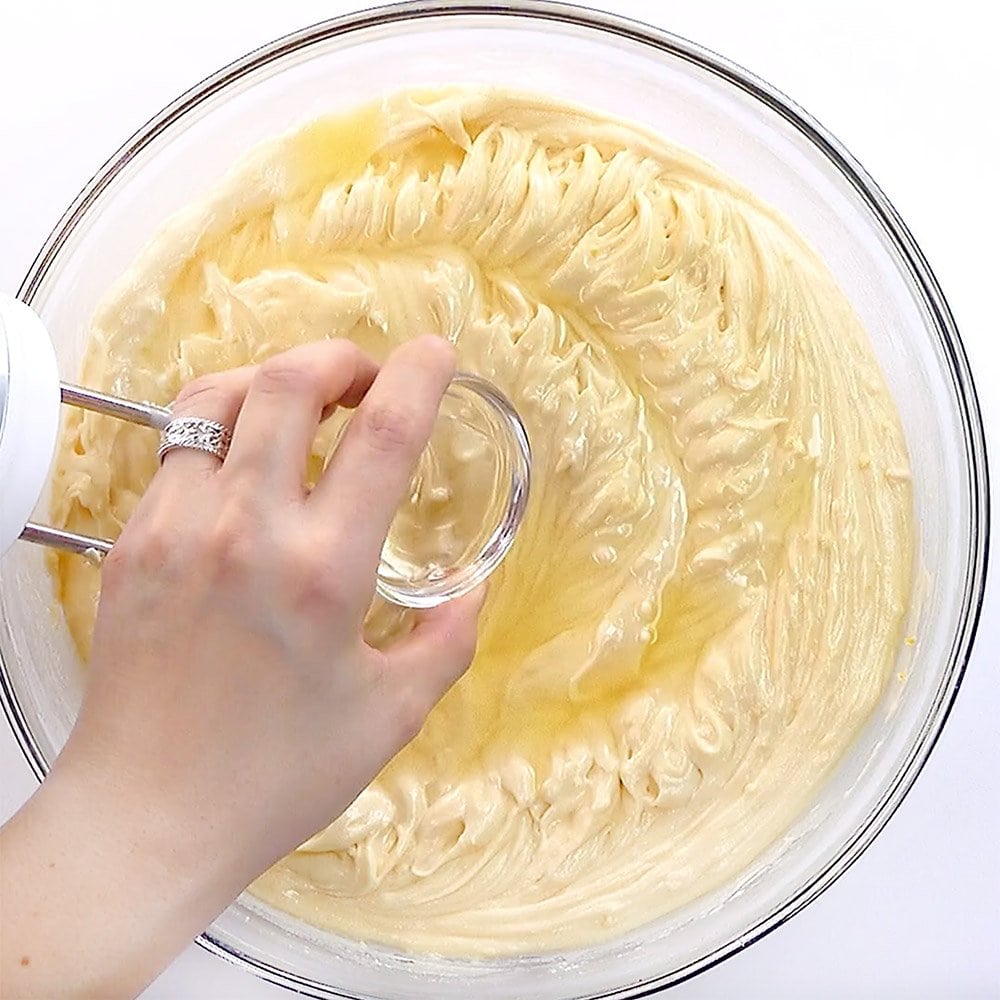
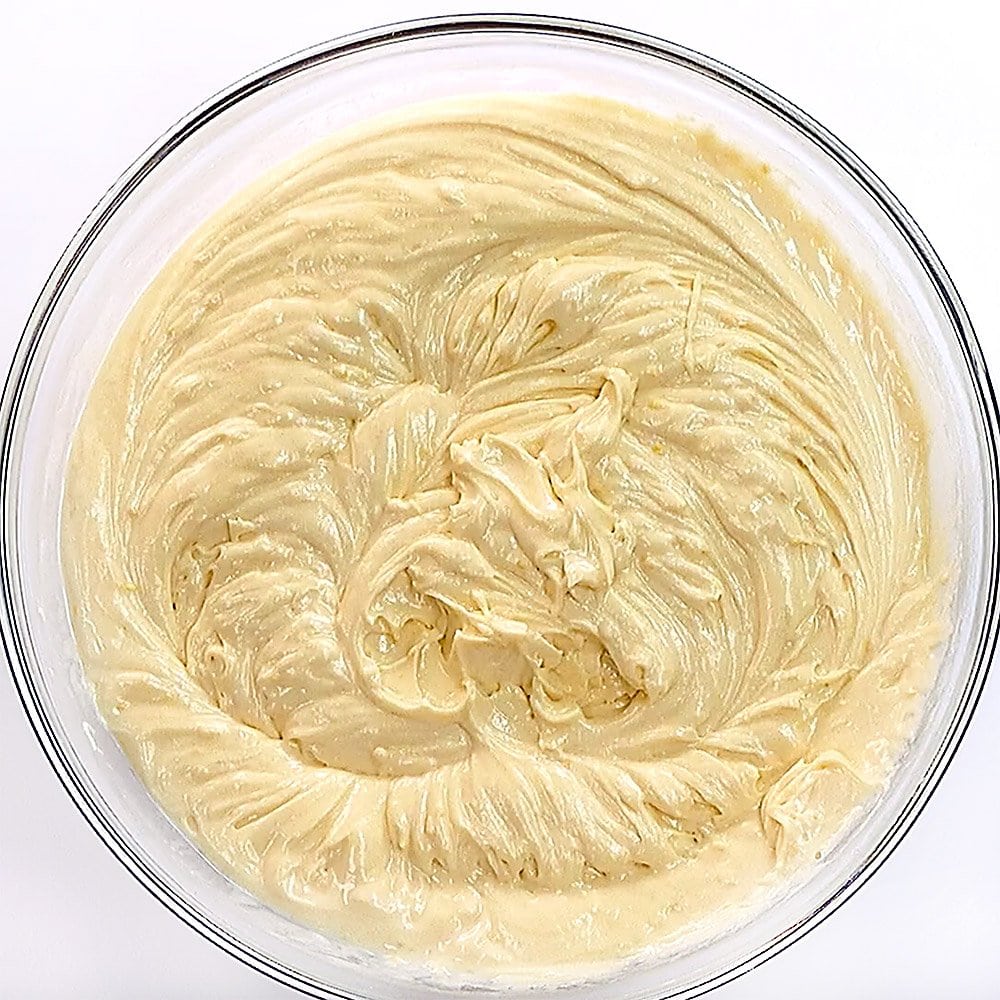
- Transfer the batter to the prepared pan, smooth the top with a spatula, and firmly tap the pan on the counter to release any air bubbles.
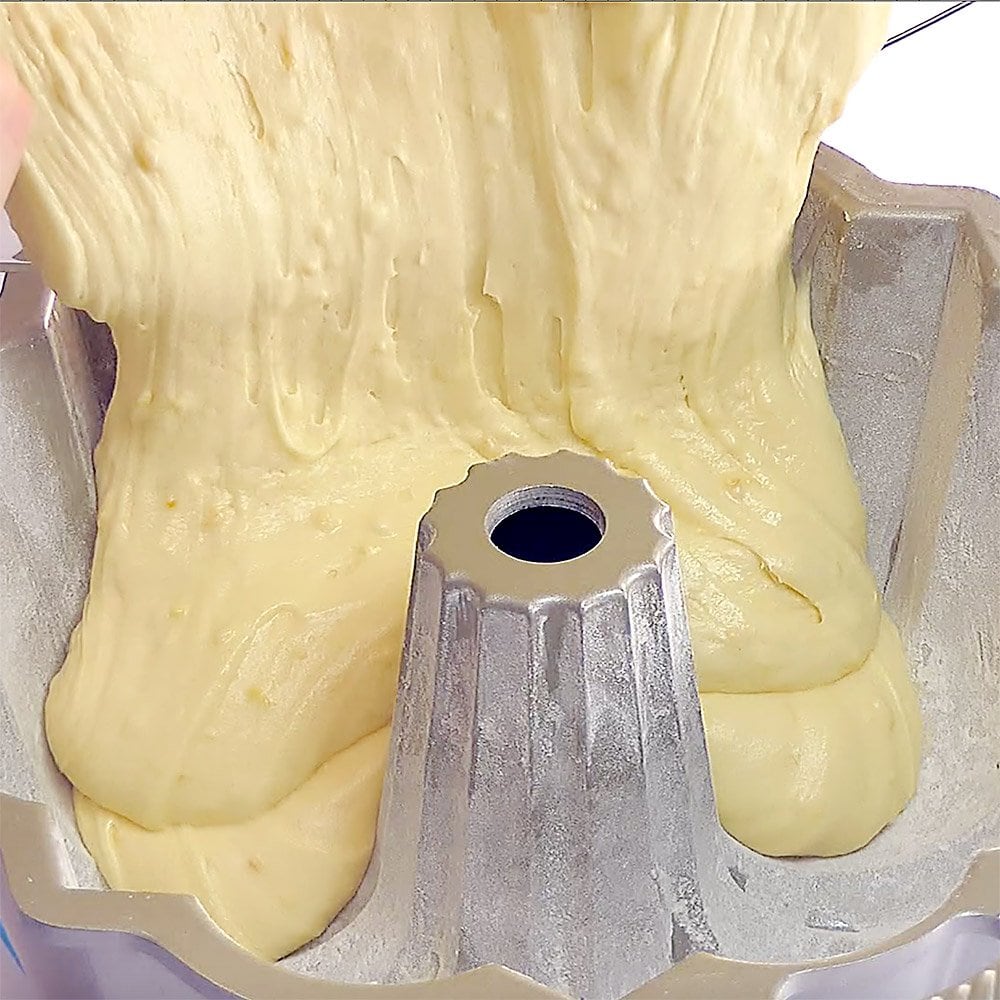
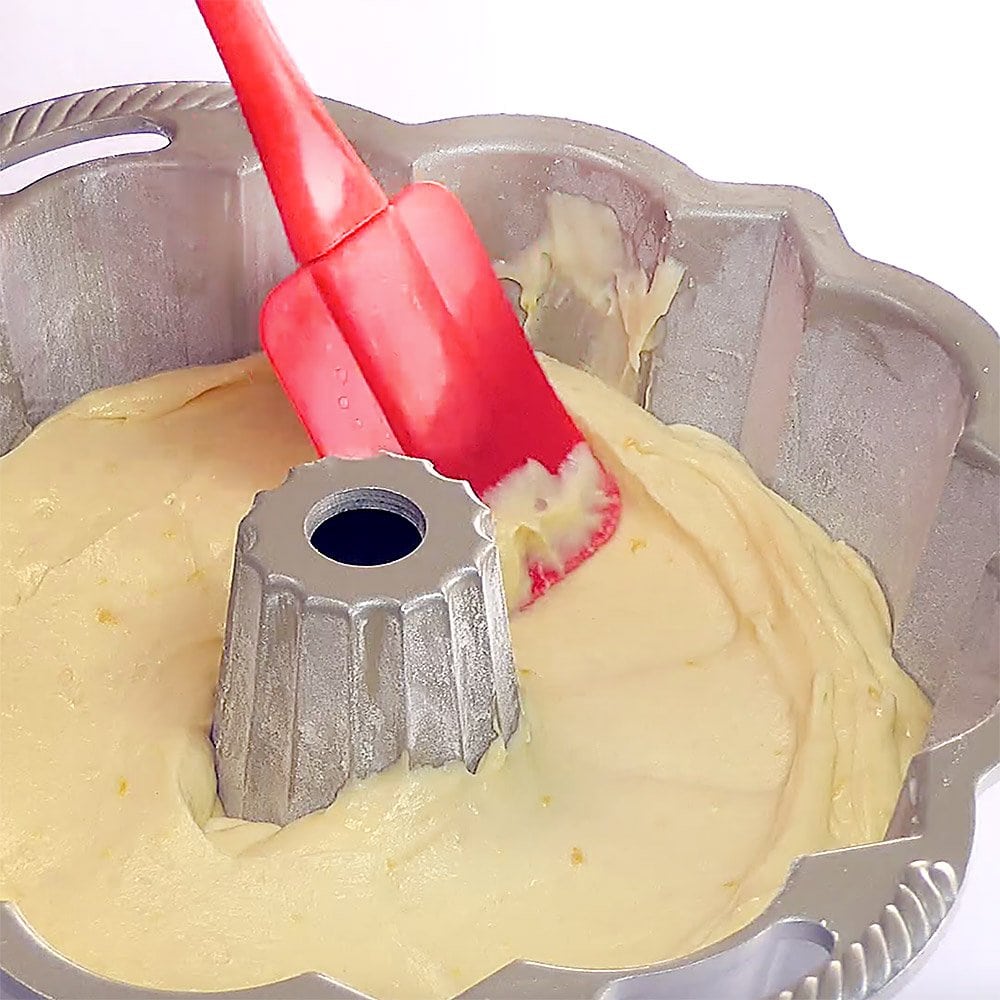
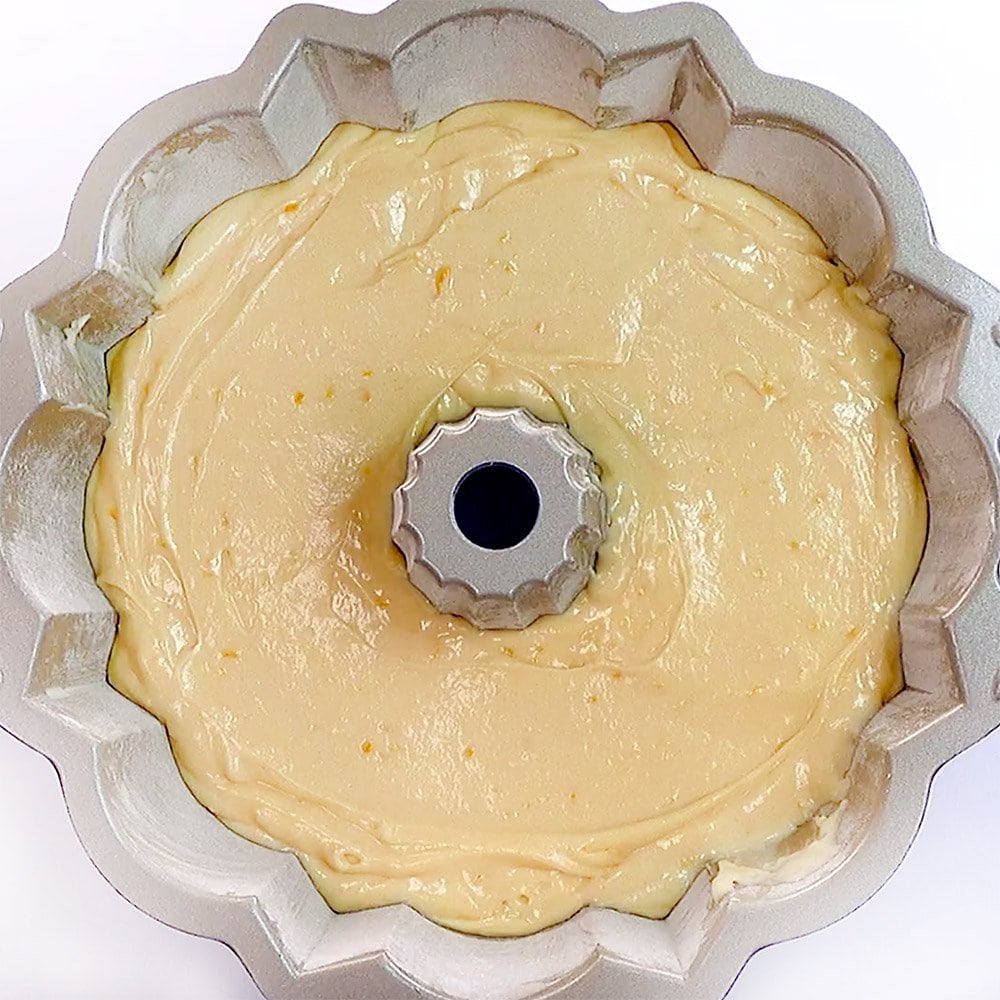
- Pop the pan in the oven and bake until the cakes tests done.
- After 15 minutes, turn out your Lemon Pound Cake onto a cooling rack and cool completely.
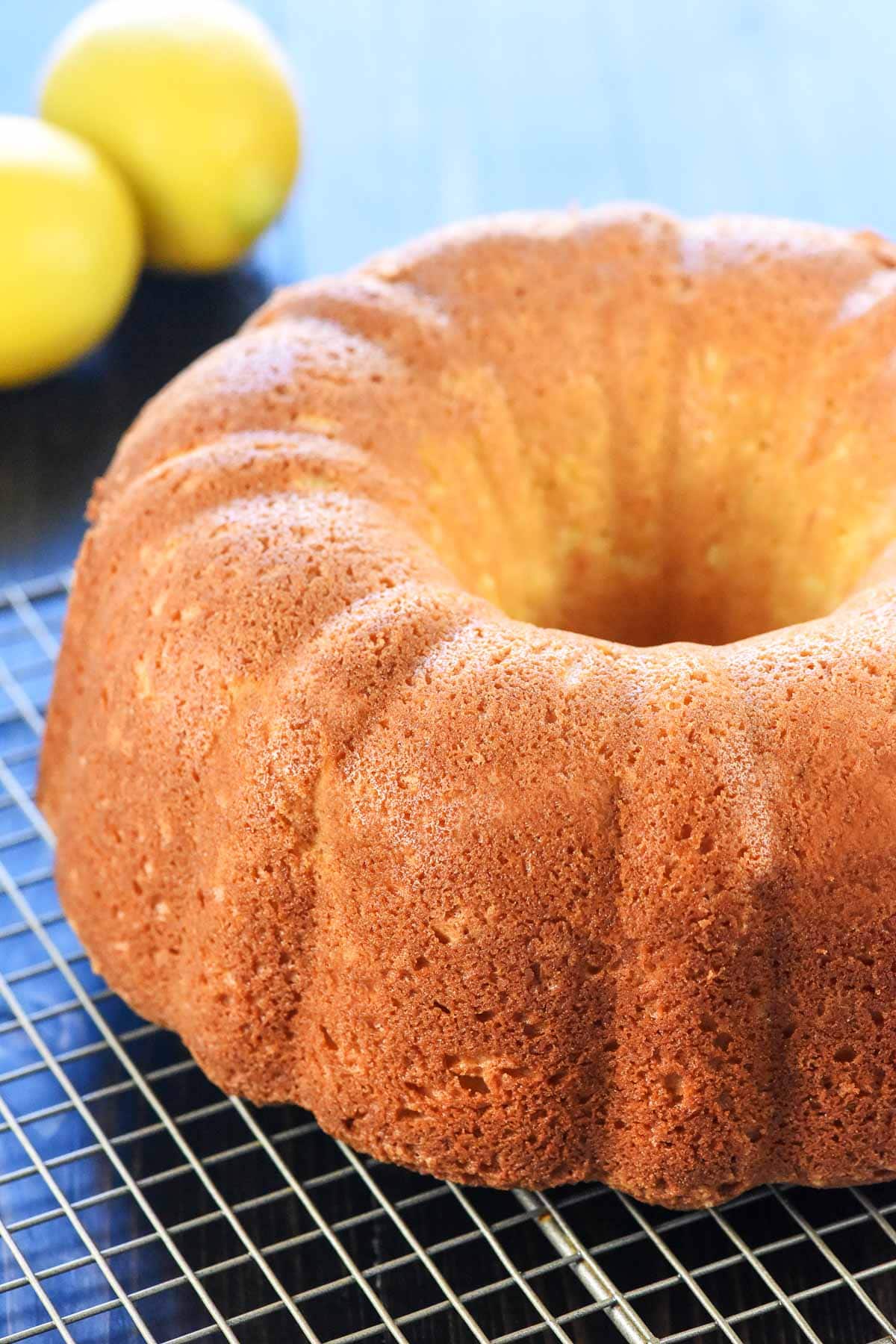
Make the Glaze
- For the finale, a puckery-sweet lemon glaze puts everything over the lemon-lovin’ top. It's as simple as stirring even more fresh lemon juice into powdered sugar. Then simply pour the lemon glaze over the top of the cooled pound cake.
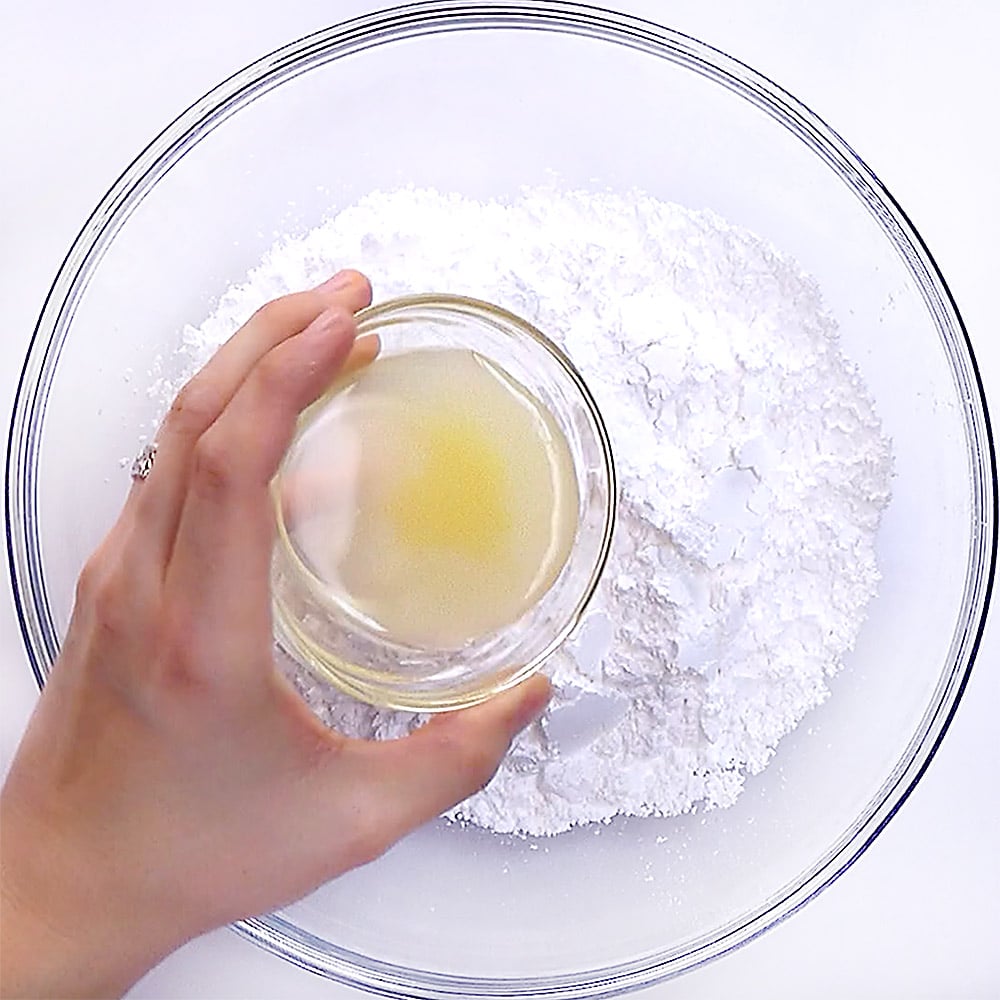
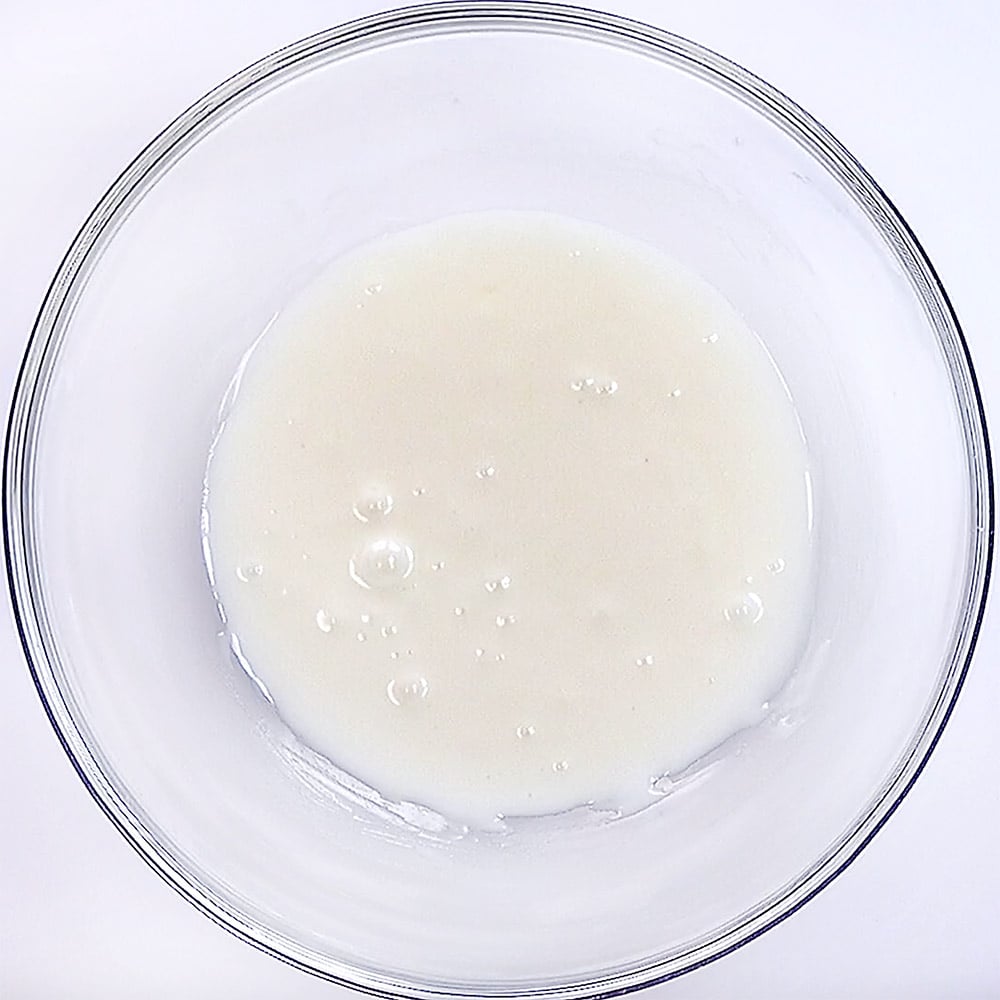
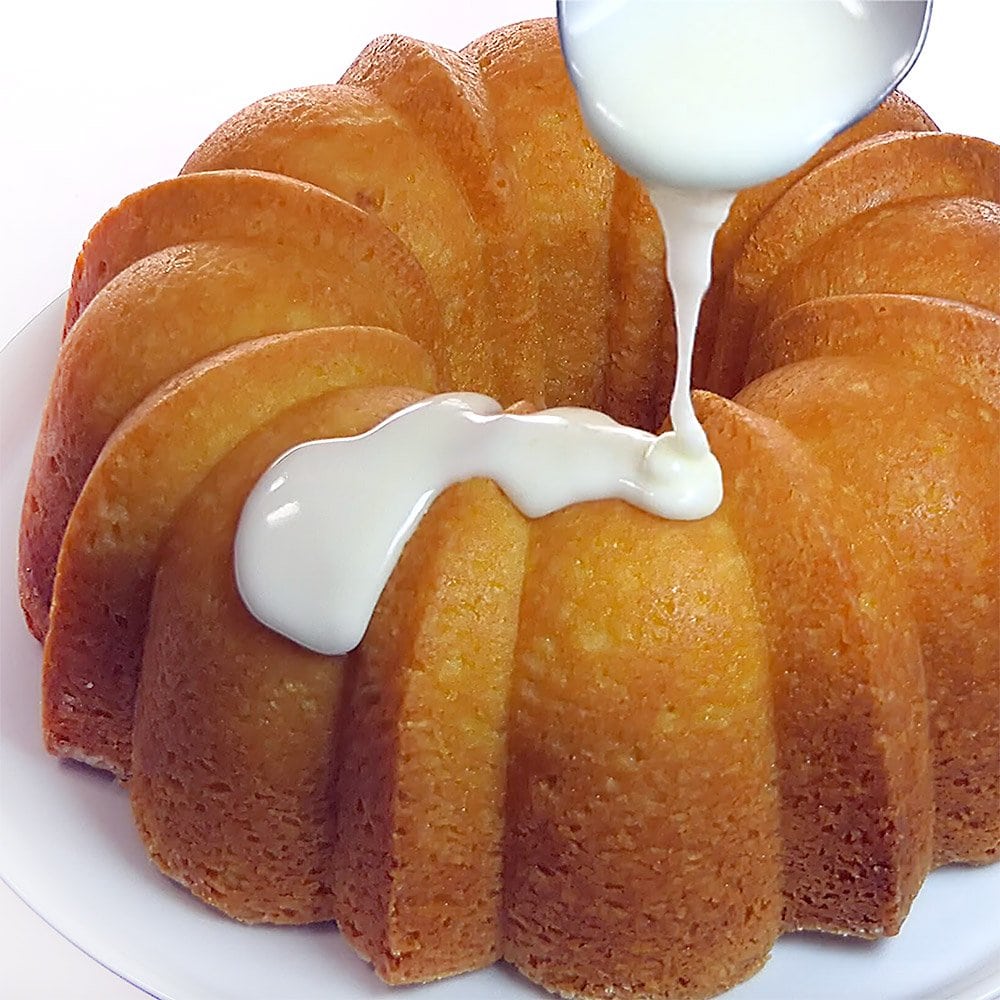
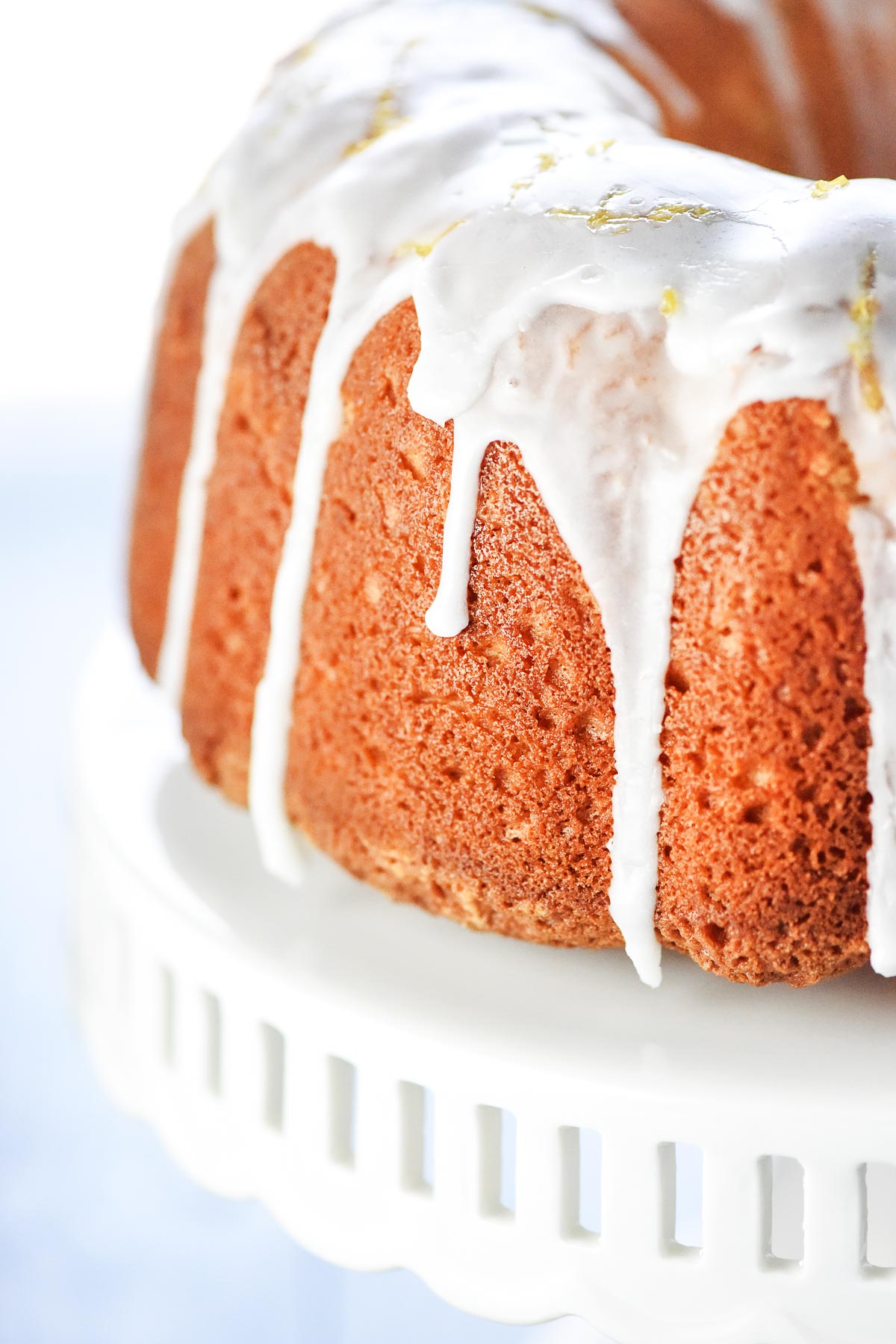
Lemon Simple Syrup Option
This traditional Lemon Pound Cake gets its soft, dense texture and moist crumb from the combo of butter, sour cream, and half a dozen (yep — a whole six of 'em) eggs. I decided to slightly decrease the sugar from the original recipe. My cake still turned out nice and sweet with a decidedly crisp, golden crust.
So made as directed, this cake is already pretty moist and lemony. But if you want it to be over-the-top moist and lemony, you can make a half-batch of Lemon Simple Syrup from this recipe (feel free to leave out the sliced lemons).
- Poke holes all over the cooled pound cake and brush on the syrup.
- Allow it to soak in before brushing on any remaining syrup.
- Then glaze as usual.
Again, this cake turns out amazing even without a simple syrup soak. But if you'd like to add the extra step, go for it!
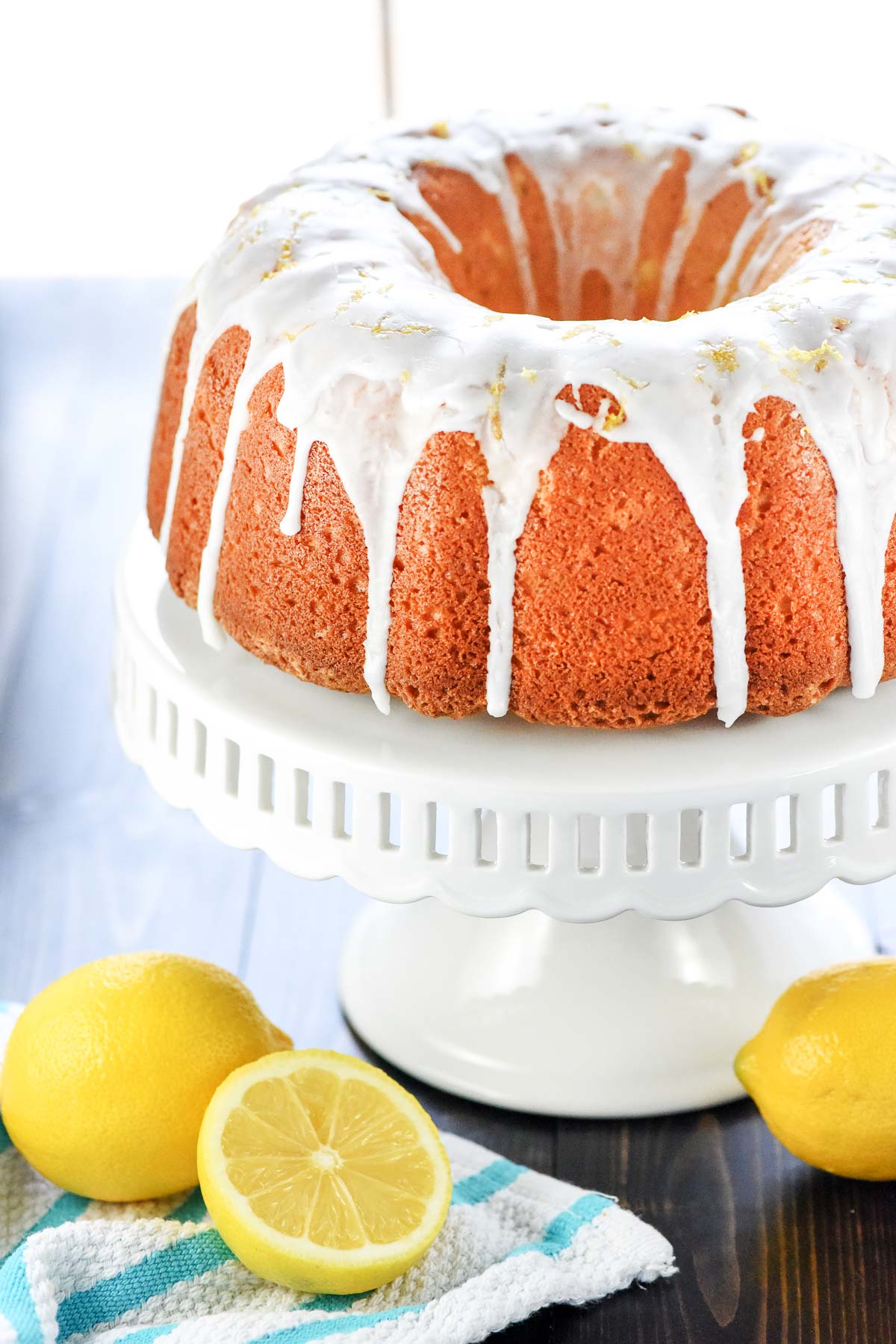
Bundt Cake Pan Size
You'll want to use a bundt pan with a 12-cup capacity.
The measurements for a pan of this capacity are typically 10- by 3-inches, but this can vary based on the "design" of the pan. So to be absolutely sure, you can measure cups of water into the pan to determine if 12 cups fit.
If you're still worried about overflow, place a baking sheet under the pan while your cake bakes. As someone who is admittedly paranoid and doesn't like cleaning my oven, I always do.
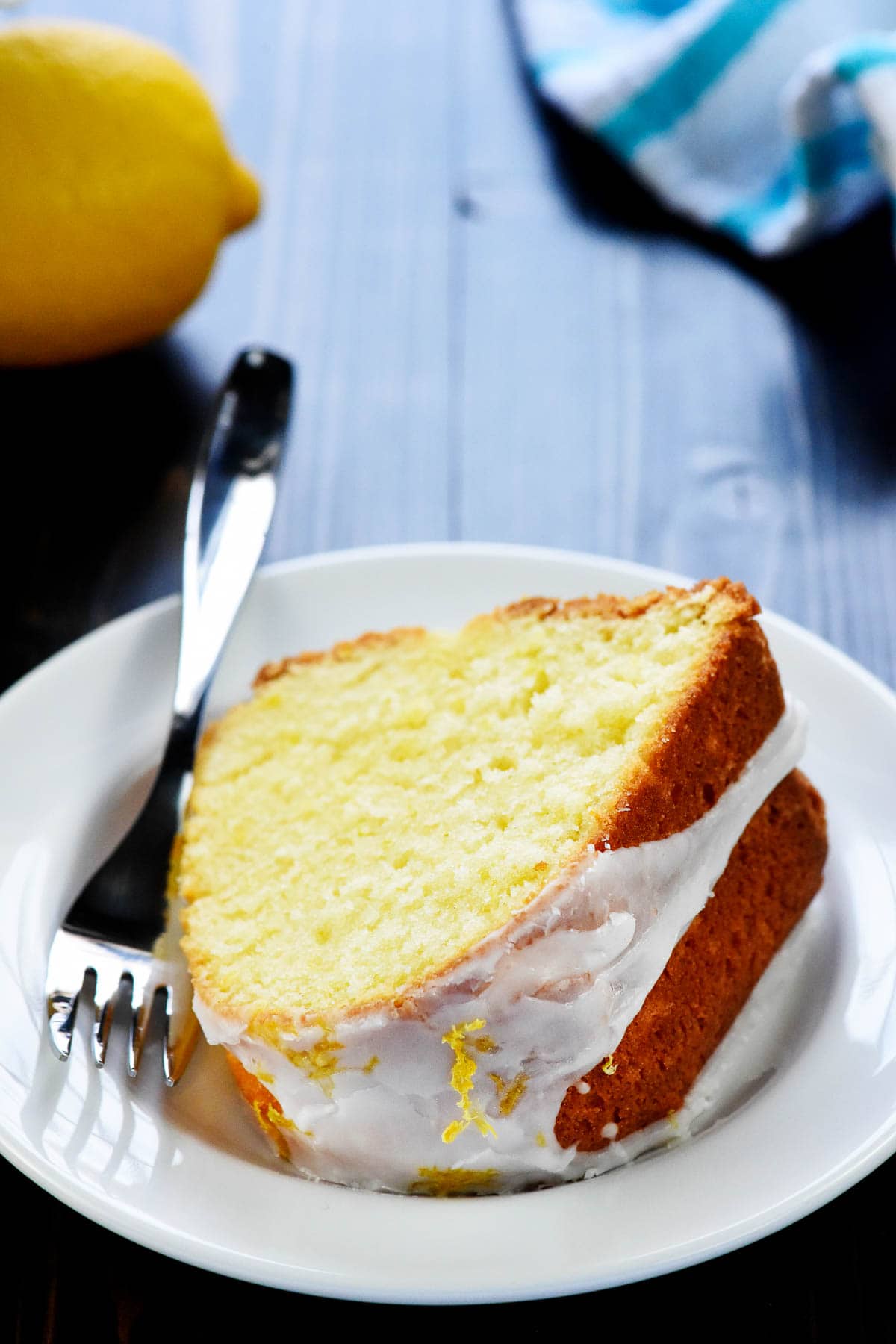
Converting to Loaf Pans
Pan Size
Bundt cake recipes typically bake beautifully in loaf pans, but you just need to ensure that the size of your loaf pans will hold all of the bundt cake batter.
To make it simple, a 12-cup capacity bundt pan can be evenly divided between TWO 8.5- by 4.5-inch loaf pans, which have a capacity of 6 cups each.
If your loaf pans are smaller than that, you will have extra batter that can be baked in a few muffin cups.
If your loaf pans are larger than that, just be aware that your loaves won't rise up as high in the pans.
Either way, I recommend putting a sheet pan under your loaf pans to catch any potential spills as a result of your pan conversion experimentation. 😉
Baking Time
Along the same lines, the baking time will be reduced if you convert this Lemon Pound Cake recipe to loaf pans, but I can't say by *exactly* how much since the size of loaf pans can vary.
My best advice is to stay near the oven while your lemon loaves bake and keep an eye on them. The "cross section" of cake in a loaf pan won't be much thinner than the cross section from a bundt pan. In other words, even though you're dividing the batter between two pans, the baking time WILL NOT be cut in half.
I recommend testing your lemon loaves for doneness about 20 minutes earlier than the recommended baking time for the Lemon Pound Cake recipe. But in the end, you will likely find that two loaves only take about 10-15 minutes less than the baking time for a typical bundt cake.
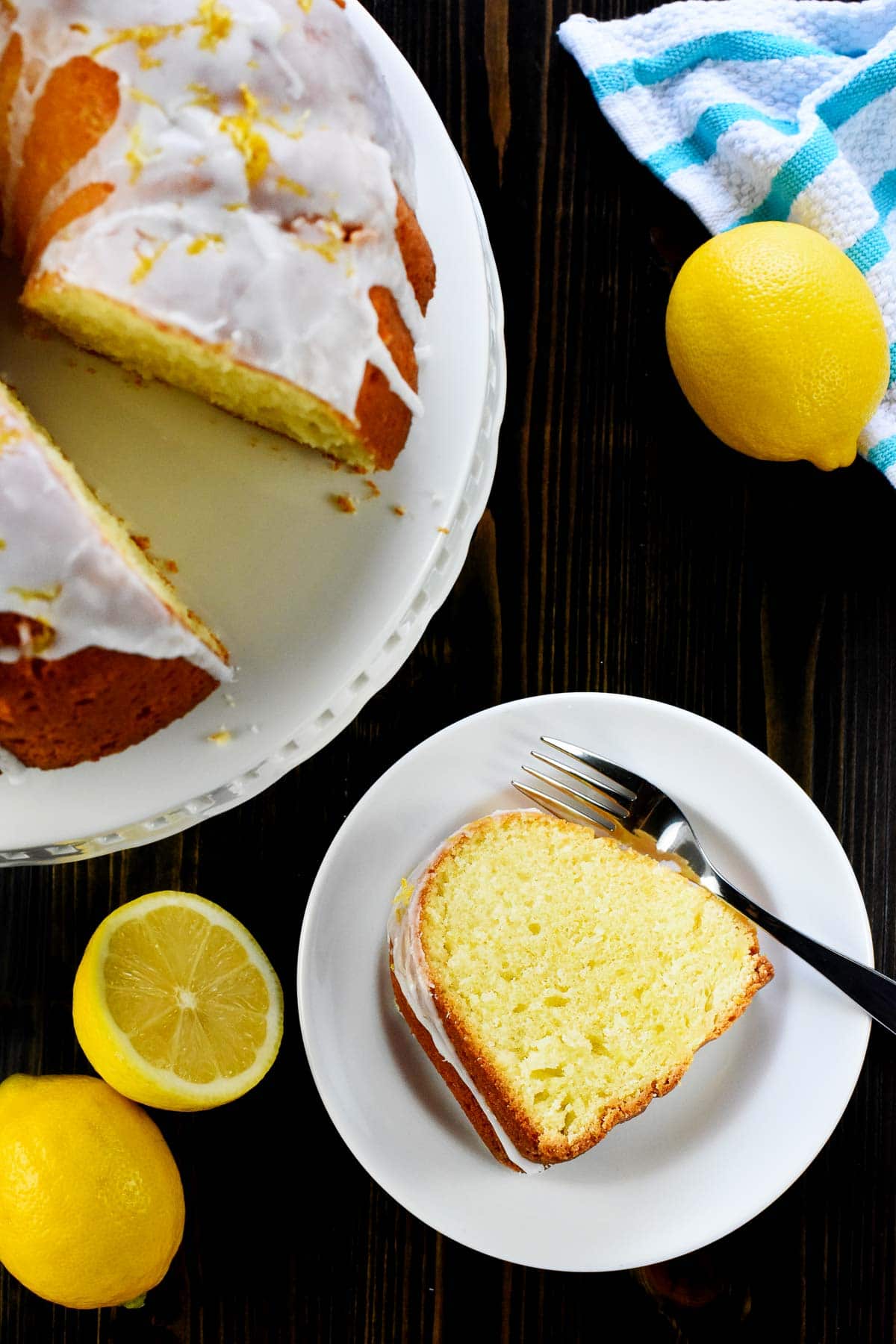
And that’s it!
This BEST Lemon Pound Cake is the perfect antidote for any springtime lemon cravings.
My family goes crazy over it every time. I mean, my lemon-fanatic middle son obviously loves it. But everyone who tries it positively scarfs it down…the whole cake never lasts long at all.
Helpful Tips, Tricks, and Equipment
- Some people swear by a no-stick baking spray that contains flour, but I think the safest way to ensure that your pound cake will release from the pan is to very generously grease and flour the pan.
- For the best results, make sure your ingredients are at room temperature, which helps ensure a light, airy, fluffy texture. Room temp ingredients will also whip together more easily.
- Don't overmix after adding the dry ingredients or your cake may turn out dense.
- The lemon juice is added towards the end of the recipe, along with the flour and sour cream. This prevents the batter from curdling, which could adversely affect the final texture of the cake.
- In addition to the glaze, slices of this Lemon Pound Cake are also delicious topped with glossy Blueberry Compote!
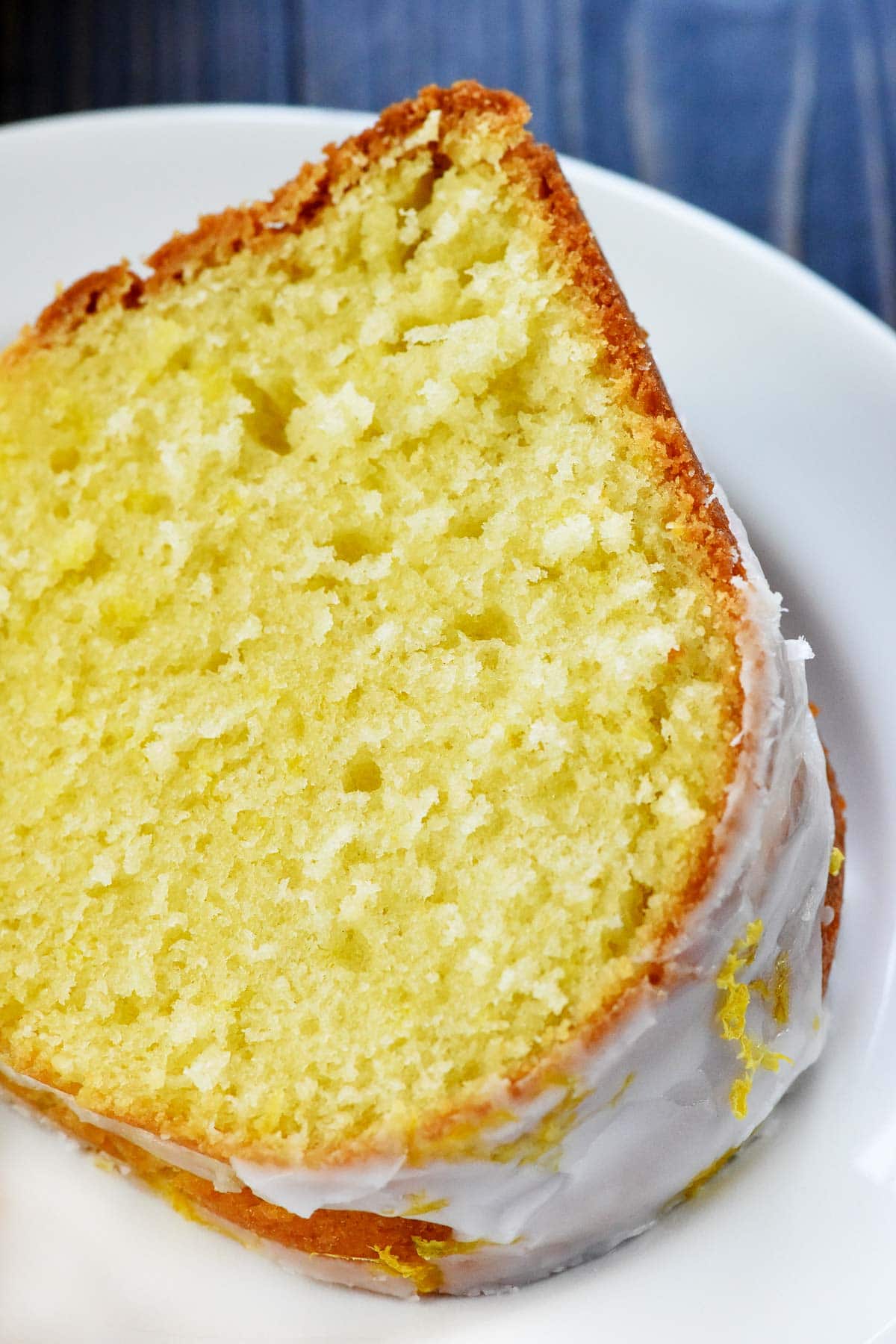
So how about you?
Are you a fan of a simple, classic pound cake?
Do you adore lemon desserts, but relegate them to the spring and summer months? Or are you the type to choose the slab of lemon pound cake out of the Starbucks bakery case even in December?
Finally, do you adore an icing that makes your mouth pucker?
If you answered "yes" to any or all of the above questions, this scrumptious, easy Lemon Pound Cake recipe is a must-make! I hope you get to try it soon. 🙂
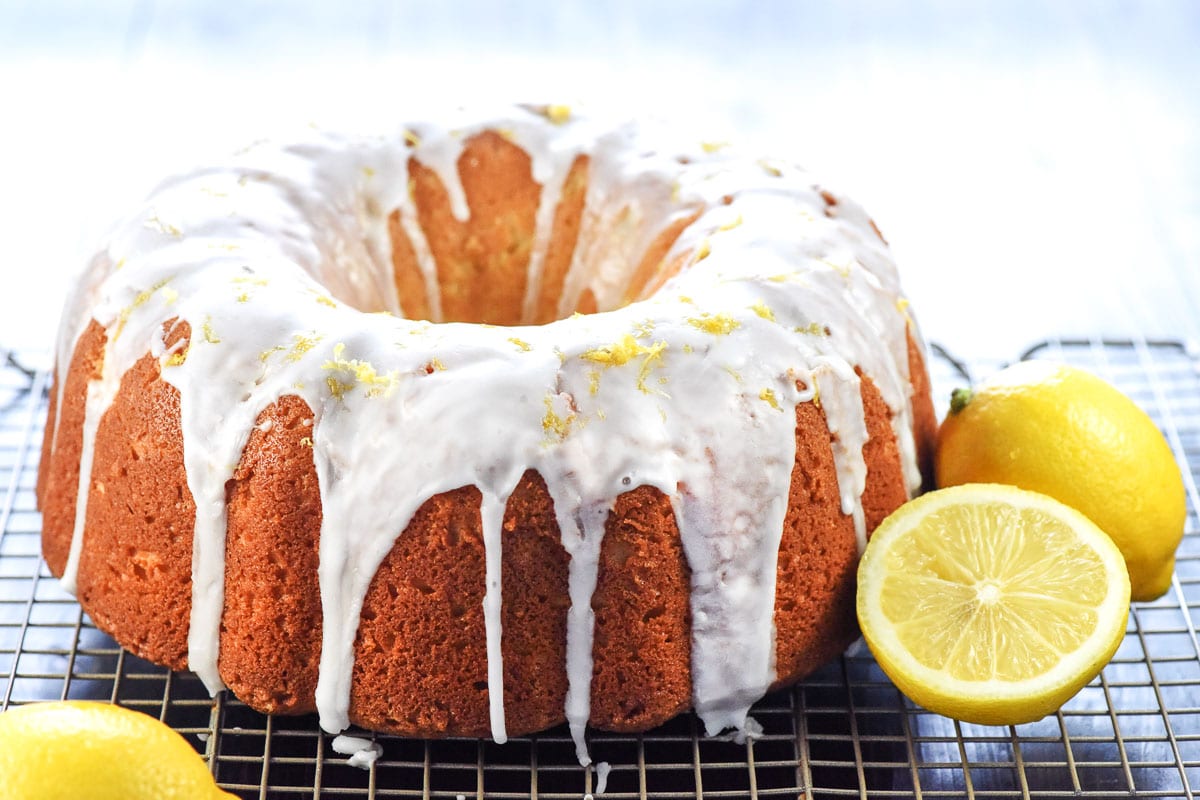
More Lemon Treats
- Lemon Sugar Cookie Bars
- Lemon Blueberry Muffins
- Lemon Fruit Dip
- The BEST Lemon Cupcakes with Lemon Cream Cheese Frosting
- Lemon Blueberry Overnight Baked French Toast with Lemon Syrup
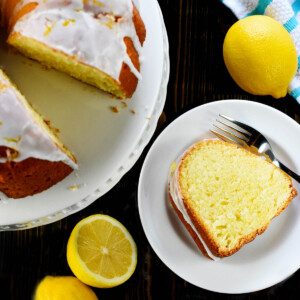
The BEST Lemon Pound Cake (Easy + Homemade)
Video
Ingredients
- 3 cups all-purpose flour
- ½ teaspoon baking soda
- ½ teaspoon salt
- 2 tablespoons lemon zest
- 1 cup (2 sticks) unsalted butter, at room temperature
- 2 ½ cups sugar
- 6 large eggs, at room temperature
- 1 cup sour cream, at room temperature
- 2 tablespoons freshly-squeezed lemon juice
- 1 teaspoon pure lemon extract
For the glaze:
- 1 ½ cups powdered sugar
- 2-3 tablespoons freshly-squeezed lemon juice
Instructions
- Arrange a rack in the center position of the oven and preheat to 325°F. Generously grease and flour a 12-cup bundt pan and set aside.
- In a large bowl, whisk together the flour, baking soda, salt, and lemon zest. In another large bowl, use an electric mixer to cream together the butter and sugar. Increase the speed to medium-high and beat for about 5 minutes until light and fluffy. Add the eggs, one at a time, mixing well after each addition.
- With the mixer set to low speed, alternately add half of the flour mixture, half of the sour cream, and then the remaining flour mixture, sour cream, lemon juice, and lemon extract. Mix until all ingredients are just combined, taking care not to overmix.
- Transfer the batter to the prepared pan, smooth the top with a spatula, and firmly tap the pan on the counter to release any air bubbles. Bake for 1 hour and 15 minutes (up to 1 hour hour and 30 minutes) until a few moist crumbs stick to a toothpick inserted in the center. Cool cake in the pan for 15 minutes before turning out onto a wire to finish cooling completely.
- For the glaze, measure the powdered sugar into a bowl and stir in 2 tablespoons lemon juice with a spoon until completely smooth. Add a bit more lemon juice if the glaze is too thick. Drizzle the glaze over the cooled cake and allow to harden and set. If desired, garnish with additional lemon zest.
Equipment Needed
- 12-cup Non-stick Bundt Pan These ones from Nordic Ware are my favorite!
- Electric Mixer This one from Kitchenaid works great!
Notes
- For the best results, make sure your ingredients are at room temperature, which helps ensure a light, airy, fluffy texture. Room temp ingredients will also whip together more easily.
- Don't overmix after adding the dry ingredients or your cake may turn out dense.
- The lemon juice is added towards the end of the recipe, along with the flour and sour cream. This prevents the batter from curdling, which could adversely affect the final texture of the cake.
- The first time you make this cake, you may want to test it at an hour just in case your oven runs on the hotter side.
- For a Lemon Pound Cake that's extra moist and lemony, you may brush the cake with a lemon simple syrup while it's still warm, and then glaze once it's completely cool.
- To make (optional) lemon simple syrup: Combine ¼ cup water + ¼ cup sugar in a small saucepan over medium-high heat. Stir occasionally, to dissolve the sugar, and bring to a boil. Remove from the heat and stir in 2 tablespoons of lemon juice.
Nutrition
Adapted from Taste of Home.
Post originally published on March 19, 2018, and updated on March 24, 2019, and March 31, 2022, and March 18, 2024.


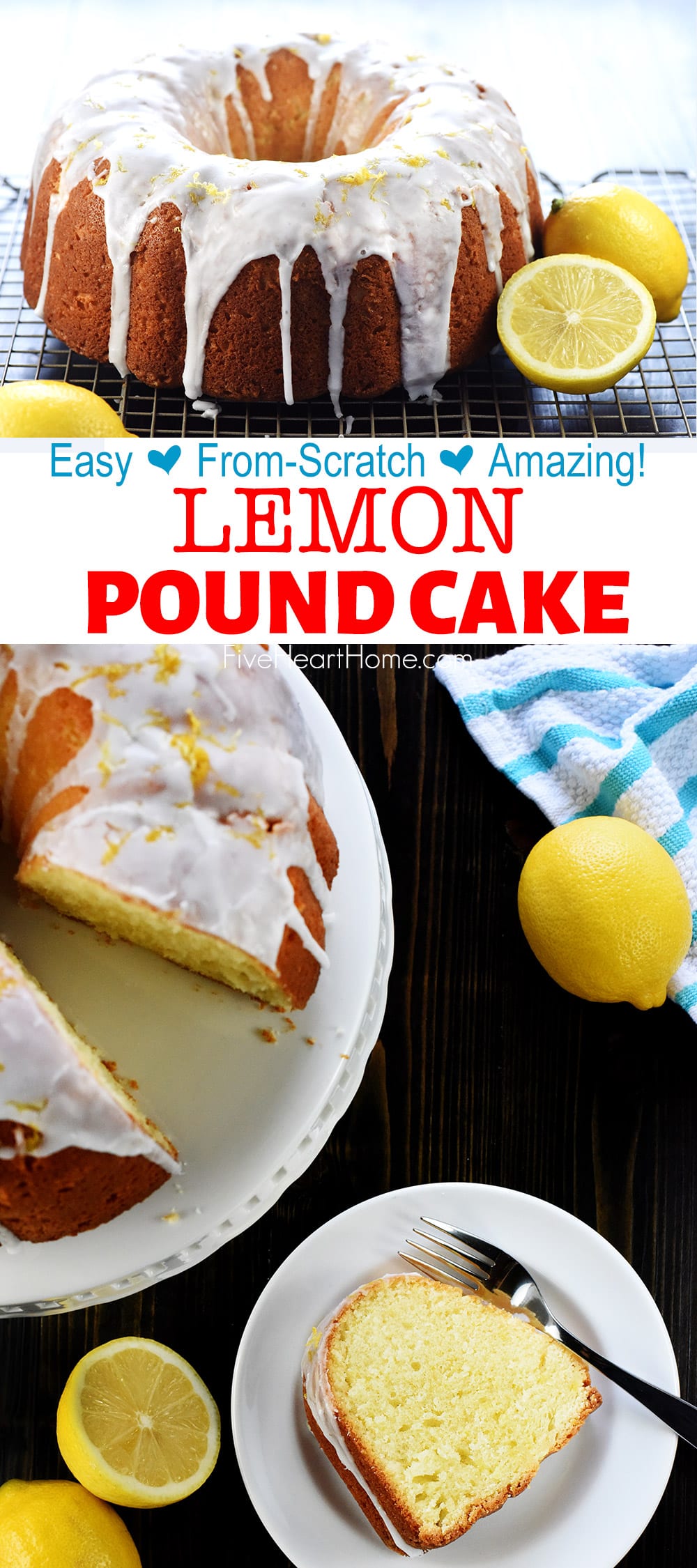
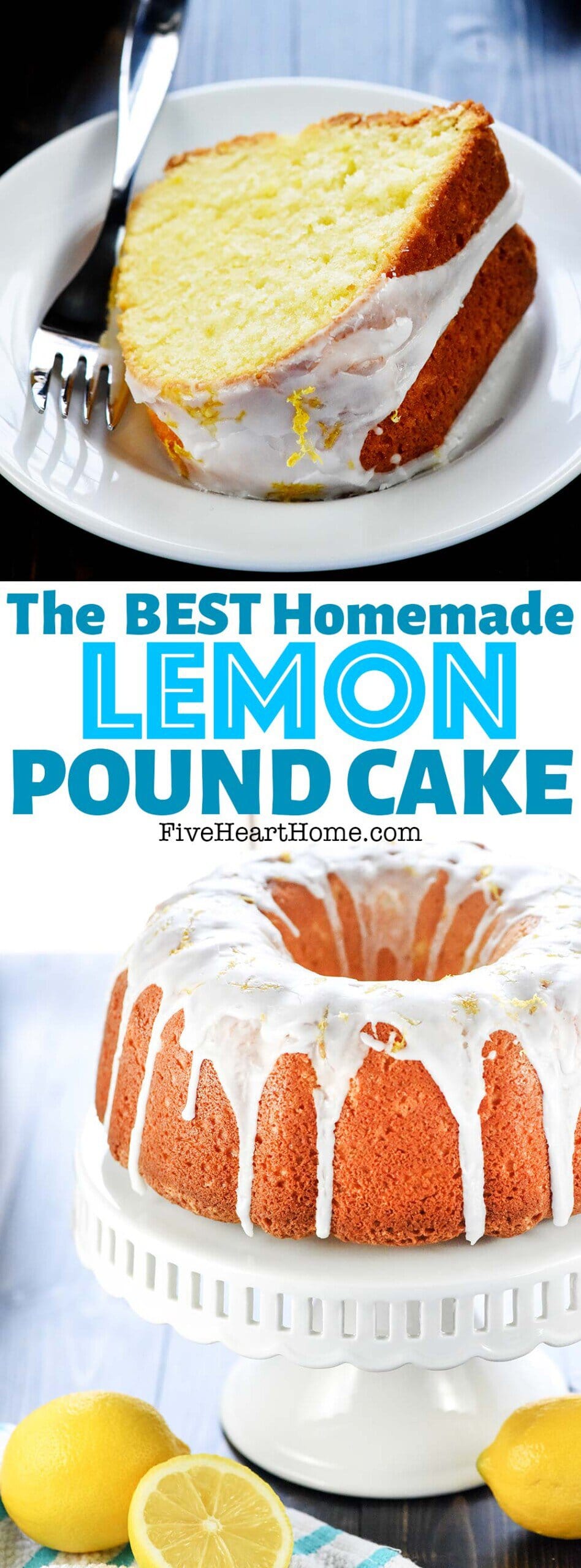
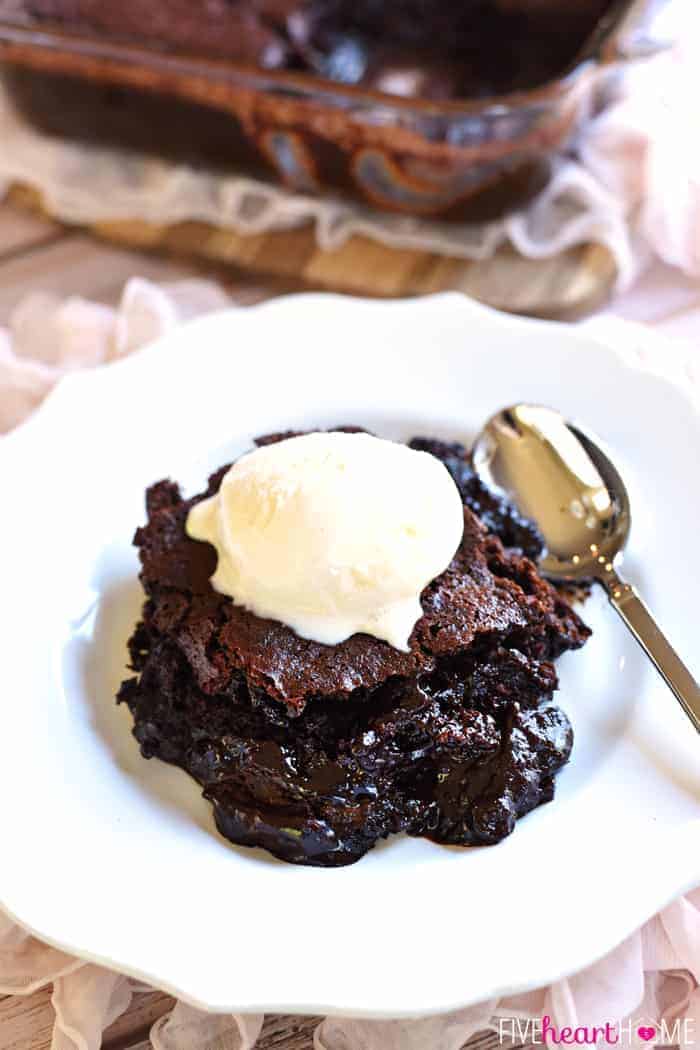


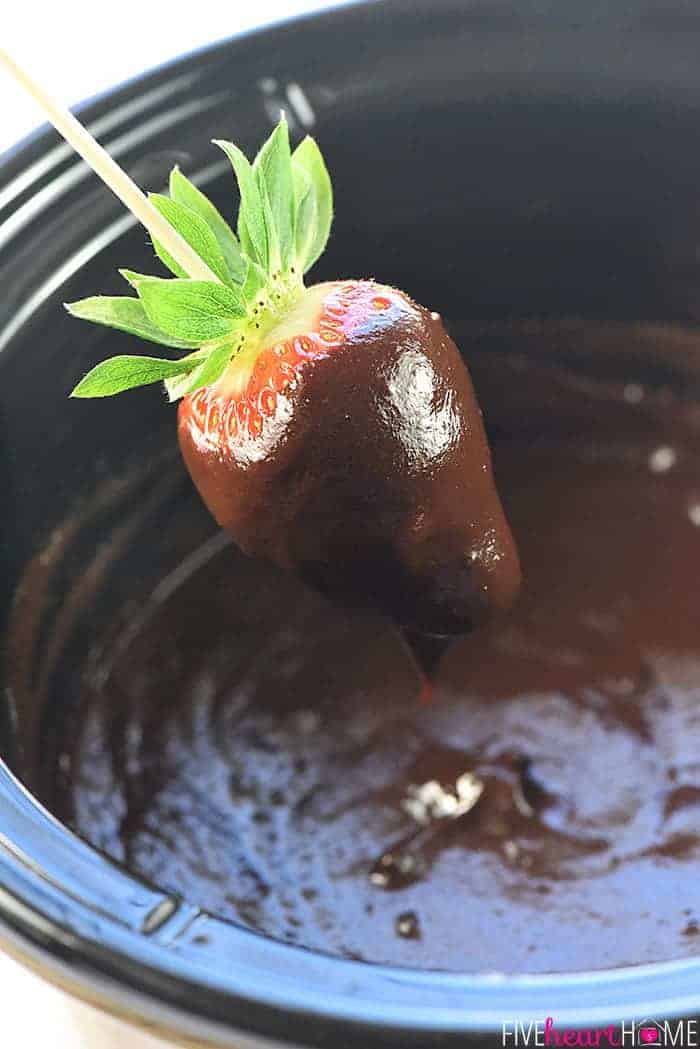
Perfect lemon flavor, glaze adds nice sweetness as the cake itself is not too sweet. My oven apparently runs on the hotter side, so I’d probably bake 1 hour - 1 hr 10 min at most next time. Lovely cake!!
This cake is divine.
I adjusted the recipe a bit but my goodness, so good. I added Trader Joe’s lemon curd to the butter and sugar mixture. Then i substituted Greek yogurt for the sour cream and added a quarter cup of lemon juice to the batter after the yogurt and it turned out so dense and delicious. I also did the lemon glaze while it was still warm instead of the icing and it was the best decision. I think next time I’ll do a half cup of lemon juice since the batter seemed to tolerate the quarter cup and came out so dense. Thank you for this recipe!
This is my second time making your lemon cake it’s very delicious
Can I add poppy seeds?
Sure! 🙂
Just lovely and easy to make!
I felt this cake was dry and not enough lemon flavor
Can I use a stand mixer
Yes! 🙂
Can I use more fresh lemon juice instead of lemon extract?
Hi Jill! I would omit the lemon extract and perhaps increase the amount of lemon zest in its place to boost the lemon flavor. I'm afraid that adding too much more lemon juice could make the batter too wet.
Can this cake be frozen until ready to use ? Also I used a Bundt cake pan
Hi Carol! This Lemon Pound Cake can be frozen, but make sure it's completely cool and I would not glaze it first. Tightly wrap the cake in plastic wrap followed by a couple layers of aluminum foil, then label and freeze for up to 3 months. Hope that helps! 🙂